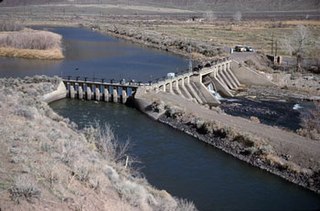
Derby Dam is a diversion dam built from 1903 to 1905 on the Truckee River, located about 20 miles (32 km) east of Reno in Storey and Washoe counties in Nevada, United States. It diverts water into the Truckee Canal that would otherwise enter Pyramid Lake. The canal feeds Lake Lahontan reservoir in the Carson River watershed, where it is used for irrigation.

The Virginia and Truckee Railroad is a privately owned heritage railroad, headquartered in Virginia City, Nevada. Its private and publicly owned route is 14 miles (23 km) long. When first constructed in the 19th century, it was a commercial freight railroad which was originally built to serve the Comstock Lode mining communities of northwestern Nevada.
The Carson and Colorado Railway was a U.S. 3 ft narrow gauge railroad that ran from Mound House, Nevada, to Keeler, California below the Cerro Gordo Mines. It was incorporated on May 10, 1880 as the Carson and Colorado Railroad, and construction on the railroad began on May 31, 1880. The narrow gauge track was chosen to reduce cost. Much of the route now parallels U.S. Route 95 Alternate, U.S. Route 95, Nevada State Route 360, U.S. Route 6, and U.S. Route 395.

Sonora Pass is a mountain pass in the Sierra Nevada in California. It is the second-highest in California and in the Sierra Nevada. lower by 321 ft. than Tioga Pass to the south. State Route 108 traverses the pass, as does the Pacific Crest Trail.

Laws is an unincorporated community in Inyo County, California. Laws is located 4 miles (6.4 km) northeast of Bishop on U.S. Route 6, towards the Nevada state line.
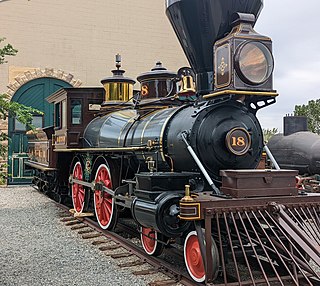
The Virginia and Truckee 18 Dayton is a historic standard gauge steam locomotive on display in Sacramento, California. It spent its working life on the Virginia and Truckee Railroad.

The Nevada–California–Oregon Railway was a 3 ft narrow gauge railroad originally planned to connect Reno, Nevada, to the Columbia River. However, only 238 mi (383 km) of track were laid so service never extended beyond Lakeview, Oregon. Because of the company’s reputation for mismanagement, it was often called the "Narrow, Crooked & Ornery" railroad.
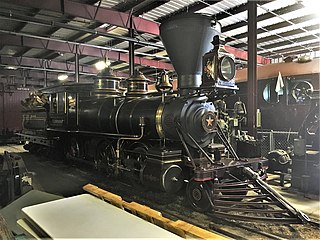
The Glenbrook is a 2-6-0, Mogul type, narrow-gauge steam railway locomotive built by Baldwin Locomotive Works in 1875 for the Carson and Tahoe Lumber and Fluming Company's 3 ft narrow-gauge railroad.

St. Peter's Episcopal Church is a large historic Carpenter Gothic Episcopal church building located at the corner of Division and Telegraph streets in Carson City, Nevada. Built in 1868, it is the oldest Episcopal church still in use in Nevada. On January 3, 1978, it was listed on the National Register of Historic Places.

The Danville Southern Pacific Train Depot in Danville, California is located at 205 Railroad Ave. and W Prospect Ave. It was built in 1891 on land donated by John Hartz which was erected when the Martinez line was extended south to San Ramon. The first train came on June 7, 1891. Passenger service ended in 1934. The Southern Pacific Railroad trains continued to pass through town with freight until 1978 when the line was abandoned. The building was sold in 1951 for the Danville Supply and Feed store. In June 1996, it was purchased and moved 100 yards.

The Nevada–California–Oregon Railway Passenger Station is a historic train station in Lakeview, Oregon, United States. It was built in 1912 by contractor I. A. Underwood from plans by architect Frederic DeLongchamps. It was the northern terminus of the Nevada–California–Oregon Railway. The Southern Pacific Railroad company owned and operated the depot from 1928 until 1975, when it was closed. Since 1978, the building has been used as a law office and later a private residence. Because of its importance to local history, the depot was listed on the National Register of Historic Places in 1983.
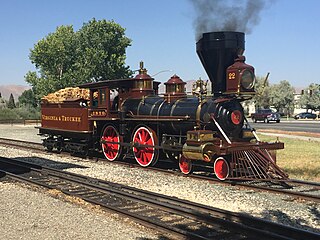
Virginia and Truckee Railroad No. 22, also known as the "Inyo", is a 4-4-0 "American" type steam locomotive that was built by the Baldwin Locomotive Works in 1875 and pulled both passenger and freight trains. The Inyo weighs 68,000 lb (31,000 kg). Its 57 in (140 cm) driving wheels deliver 11,920 lb (5,410 kg) of tractive force. In 1877 it was fitted with air brakes and in 1910 it was converted to burn oil rather than wood.
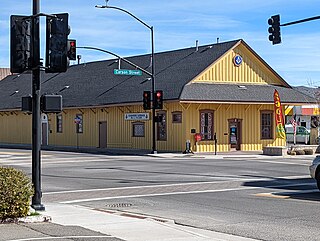
The Virginia & Truckee (V&T) Railroad Depot of Carson City, Nevada is a historic railroad station that is listed on the U.S. National Register of Historic Places (NRHP). It is significant for its association with the economically important role of the V&T railroad historically in Carson City following discovery of the Comstock Lode mine in 1859. To a lesser degree, according to its NRHP nomination, the depot building is also significant architecturally "as a well-preserved example of a wood-frame passenger depot procured from a railroad company pattern book within the V&T's former sphere of operation."

The Fernley and Lassen Railway Depot, 675 E. Main St. in Fernley, Nevada was built in 1914, and was the eastern end of the Fernley and Lassen Railway line of the Southern Pacific, 30 miles from Reno, NV. Also known as Southern Pacific Railroad Depot, it was listed on the National Register of Historic Places in 2005.
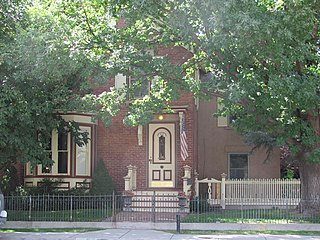
The William Spence House, at 308 S. Thompson St. in Carson City, Nevada, was built in 1875. It includes Greek Revival architecture. It was listed on the National Register of Historic Places in 1985.
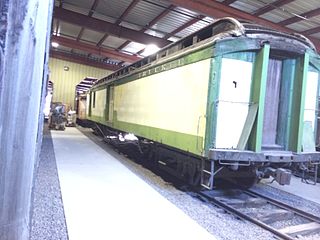
The Second Railroad Car No. 21, at the Nevada State Railroad Museum, located at 2180 S. Carson St. in Carson City, Nevada is a historic railroad car of the Virginia & Truckee line that was built in 1907. It was built by the American Car & Foundry. It was listed on the National Register of Historic Places in 1978.

The Gov. James W. Nye Mansion, at 108 N. Minnesota St. in Carson City, Nevada, United States, was built in 1860. It has also been known as St. Teresa's Rectory. It was a home of U.S. senator William M. Stewart and of Nevada territory governor James W. Nye.
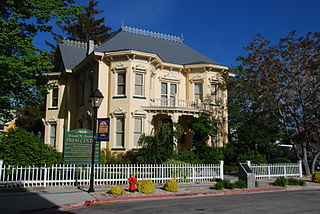
The Rinckel Mansion is a historic house in Carson City, Nevada, United States, that is listed on the National Register of Historic Places (NRHP).
Thorne, Nevada is a rail junction and former town located in Mineral County, Nevada.
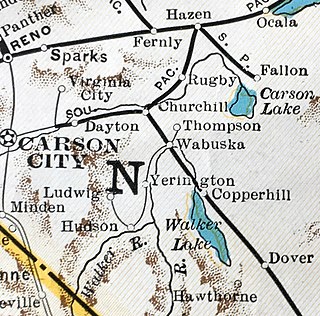
The Nevada Copper Belt Railroad was a railroad in the state of Nevada connecting Nevada-Douglas Copper Company mining facilities to the Southern Pacific's former Carson and Colorado Railway subsidiary at Wabuska, Nevada. The railroad was built south from Wabuska to the Walker River at Mason, Nevada in 1910, and began operations on 1 March. Railroad construction then proceeded up the West Walker River canyon from Mason to leave the river at Hudson reaching the Nevada-Douglas Copper Company mine at Ludwig on 1 November 1911. Rails also extended 2.54 miles (4.09 km) north from Wabuska to a smelter at Thompson. Agricultural products from irrigated ranches along the Walker River provided revenues in addition to the ore traffic.





















